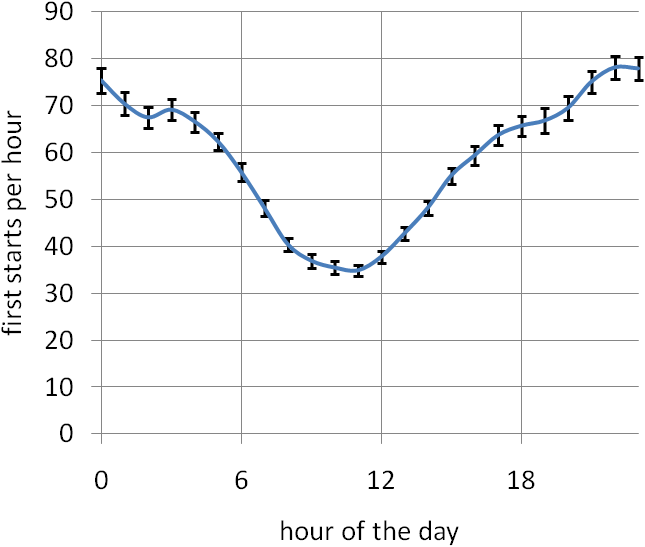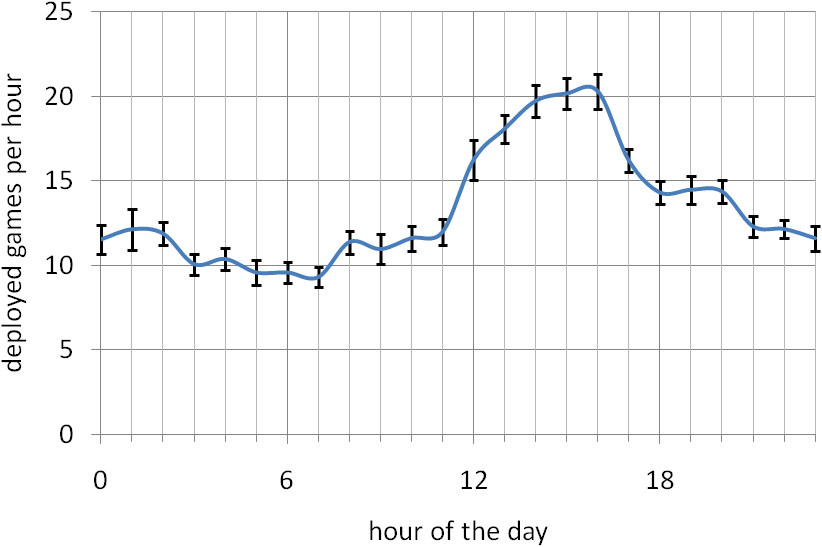Last week I thought it would be nice to collect some statistics about my apps in the Android Market. Seeing Websites like androlib.com and androidpit.de I thought it shouldn’t be a problem. However, apart from strazzere.com I haven’t found much useful information. Since I’m only interested in the stats of my own apps I took a deeper look on Google’s Developer Console for the Android Market.
I played a bit with Firebug and learned that the Developer Console is a GWT application, that JSON is used to get the app descriptions from the server, and that the GWT stuff is horrible to reverse engineer. Luckily I found a post that shows how to get the stats from the Android Marketplace with PHP/cURL. It didn’t worked for me at first but after toying around a bit it works now for me. However, I still have no clue what the JSON stuff I get from the GWT server means and I’m only guessing the most important values. It will likely break when I change anything in my developer account.
Below is the PHP script I use to fetch the data from the developer console. 99% is copied from Craige Thomas (I have absolutely no clue about PHP or cURL!). I only added the part that guesses the position of the values and the caching. The script is used to produce the output of the widget on the right.
60)) {
//do google authorization
$data = array('accountType' => 'GOOGLE',
'Email' => 'YOUR GOOGLE LOGIN'
'Passwd' => 'YOUR PASSWORD',
'source'=>'',
'service'=>'androiddeveloper');
$ch = curl_init();
curl_setopt($ch, CURLOPT_URL, "https://www.google.com/accounts/ClientLogin");
curl_setopt($ch, CURLOPT_FOLLOWLOCATION, true);
curl_setopt($ch, CURLOPT_SSL_VERIFYPEER, 0);
curl_setopt($ch, CURLOPT_POST, true);
curl_setopt($ch, CURLOPT_RETURNTRANSFER, true);
curl_setopt($ch, CURLOPT_POSTFIELDS, $data);
$output = curl_exec($ch);
$info = curl_getinfo($ch);
curl_close($ch);
//grab the AUTH token for later
$auth = '';
if($info['http_code'] == 200) {
preg_match('/Auth=(.*)/', $output, $matches);
if(isset($matches[1])) {
$auth = $matches[1];
}
}
//login to Android Market
//this results in a 302
//I think this is necessary for a cookie to be set
$ch = curl_init ("http://market.android.com/publish?auth=$auth");
curl_setopt($ch, CURLOPT_COOKIEJAR, 'cookies.txt');
curl_setopt($ch, CURLOPT_RETURNTRANSFER, true);
$output = curl_exec($ch);
//go to the Developer Console
$ch = curl_init ("http://market.android.com/publish/Home");
curl_setopt($ch, CURLOPT_COOKIEFILE, $ckfile);
curl_setopt($ch, CURLOPT_RETURNTRANSFER, true);
curl_setopt($ch, CURLOPT_COOKIEJAR, 'cookies.txt');
$output = curl_exec($ch);
//grab the JSON data
$perm = "746E1BE622B08CBF950F619C16FCFF1E";
$headers = array(
"Host: market.android.com",
"User-Agent: Mozilla/5.0 (Windows; U; Windows NT 6.1; de; rv:1.9.2.2) Gecko/20100316 Firefox/3.6.2",
"Accept: text/html,application/xhtml+xml,application/xml;q=0.9,*/*;q=0.8",
"Accept-Language: de-de,de;q=0.8,en-us;q=0.5,en;q=0.3",
"Accept-Charset: ISO-8859-1,utf-8;q=0.7,*;q=0.7",
"Keep-Alive: 115",
"Connection: keep-alive",
"Content-Type: text/x-gwt-rpc; charset=utf-8",
"X-GWT-Permutation: $perm",
"X-GWT-Module-Base: http://market.android.com/publish/gwt/",
"Referer: http://market.android.com/publish/gwt/$perm.cache.html");
//not sure what x-gwt-permutation means, I think it may have to do with which version of GWT they serve based on your browser
//Change here?
$postdata = "5|0|4|http://market.android.com/publish/gwt/|14E1D06A04411C8FE46E62317C1AF191|com.google.wireless.android.vending.developer.shared.AppEditorService|getFullAssetInfosForUser|1|2|3|4|0|";
$ch = curl_init ("http://market.android.com/publish/editapp");
curl_setopt($ch, CURLOPT_HTTPHEADER, $headers);
curl_setopt($ch, CURLOPT_POST, 1);
curl_setopt($ch, CURLOPT_POSTFIELDS, $postdata);
curl_setopt($ch, CURLOPT_COOKIEFILE, 'cookies.txt');
curl_setopt($ch, CURLOPT_RETURNTRANSFER, true);
$output = curl_exec($ch);
$output = substr($output,4);
$json = json_decode($output);
$csv = explode(',',$output);
$apps = array();
$index = 0;
$app_count = 0;
for($i = 0; $i < sizeof($csv); ++$i) {
if (is_array($json[$i])) {
$innerArray=$json[$i];
break;
}
if (strpos($csv[$i], ".") !== false) {
if ($index==1) $apps[$app_count][comments]=$csv[$i];
else if ($index==2) $apps[$app_count][rating]=$csv[$i];
else if ($index==4) $apps[$app_count][installs]=$csv[$i];
else if ($index==6) $apps[$app_count][total]=$csv[$i];
$index++;
if ($index==7) {
$index=0;
$app_count++;
}
}
}
for($i = 4; $i < sizeof($innerArray); ++$i) {
if ((substr($innerArray[$i],-1)=='k') && (substr($innerArray[$i-2],0,17)=='GetImage?imageId=')){
$app_count--;
$apps[$app_count][icon]="http://market.android.com/publish/".$innerArray[$i-2];
$apps[$app_count][name]=$innerArray[$i-3];
$apps[$app_count][size]=$innerArray[$i];
$apps[$app_count][package]=$innerArray[$i-1];
}
}
$Handle = fopen('market_stats.txt', 'w');
fwrite($Handle, '');
for($i = 0; $i < sizeof($apps); $i++) {
fwrite($Handle, "");
fwrite($Handle, ' ');
fwrite($Handle, " ');
fwrite($Handle, " | ");
fwrite($Handle, '');
fwrite($Handle, $apps[$i][name].'
');
fwrite($Handle, 'Total installs '.round($apps[$i][total]));
fwrite($Handle, " |
");
}
fwrite($Handle, '
');
fclose($Handle);
$Handle = fopen('market_stats_history.txt', 'a');
for($i = 0; $i < sizeof($apps); $i++) {
fwrite($Handle, $apps[$i][package].', ');
fwrite($Handle, round($apps[$i][total]).', ');
fwrite($Handle, time());
fwrite($Handle, "\n");
}
fclose($Handle);
}
$readHandle = fopen('market_stats.txt', 'r');
echo fread($readHandle, filesize('market_stats.txt'));
fclose($readHandle);
?>
















